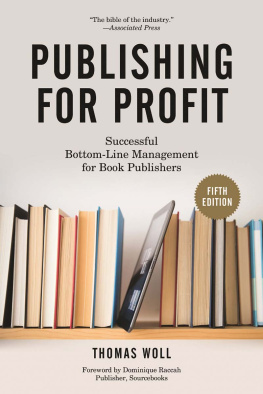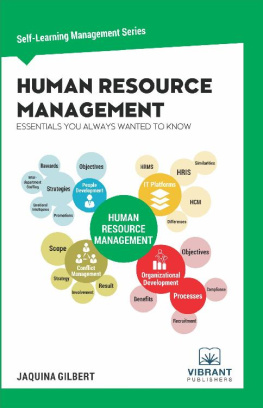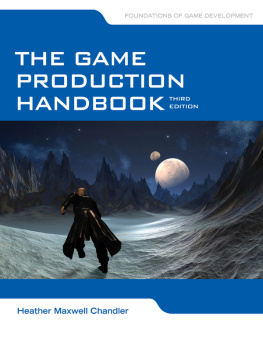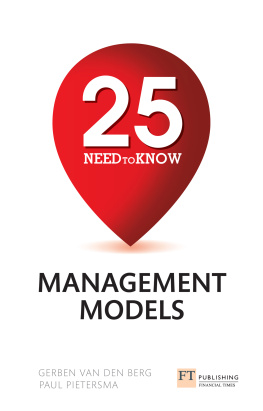
The Library of Congress has catalogued the first edition as follows:
Woll, Thomas, 1948
Publishing for profit : successful bottom-line management for book publishers / Thomas Woll.Rev. and expanded 5th ed. / foreword by Dominique Raccah.
p. cm.
Includes index.
ISBN 978-1-61374-973-9 (pbk.)
1. Publishers and publishingUnited StatesManagement. I. Title.
Z471.W58 2010
070.5068dc22
2009035709
Notice: The information in this book is true and complete to the best of our knowledge. It is offered without guarantee on the part of the author or Chicago Review Press. The author and Chicago Review Press disclaim all liability in connection with the use of this book.
Cover design: John Yates at Stealworks
1998, 2002, 2006, 2010, 2014 by Cross River Publishing Consultants, Inc.
3 Holly Hill Lane, Katonah, New York 10536
Telephone (914)232-6708 Fax (914)232-6393
E-mail:
www.pubconsultants.com
Published by Chicago Review Press, Incorporated
814 North Franklin Street
Chicago, Illinois 60610
ISBN 978-1-61374-973-9
All rights reserved. No part of this book may be reproduced or transmitted in any form or by any means, electronic or mechanical, including photocopy, recording, or any information storage and retrieval system, without prior permission from the publisher, except by a reviewer who may quote brief passages in a review.
Printed in the United States of America
Fifth edition
10 9 8 7 6 5 4 3 2 1
To my mother,
Bernice Woll,
still the best editor Ive ever known;
and
to my aunt,
Evelyn Shrifte,
who taught me more about this business
than she ever realized.
Contents
Index
List of Tables and Forms
Foreword
When I first decided to try my hand at book publishing I, of course, looked for a book that would tell me exactly how to do it. Unfortunately, Tom Woll hadnt yet written Publishing for Profit. And so I learned slowly through annual seminars and from other small press publishers. It was a slow and difficult way to learn.
Publishing is a complicated business. It takes years to learn with guidance and far longer without. Publishing for Profit is the best kind of guidance. In it Tom has covered every major subject that publishers face in building and running a book publishing company. It does several things remarkably well and in many instances it is the only book that addresses some essential aspects of publishing. For example, a number of books will show you how to create a profit-and-loss (P&L) statement for an individual title. But here you learn how to aggregate these individual P&Ls to evaluate your entire publishing program. Toms emphasis on cash flow and financial planning is particularly important for book publishers who are not always numerically inclined, and he presents all of these concepts in a way that is, amazingly, neither dry nor intimidating.
Publishing is ultimately a business of decisions. A careful reading of Publishing for Profit will show you all the ways that decisions about pricing, print runs, and all the other essential minutiae of publishing a book can threaten or enhance your publishing program. For the brand-new publisher, you will make many decisions early on that are remarkably sticky. Bad decisions can haunt you for years; but if the decisions you make are sound, you will be laying the foundation for a profitable and enjoyable business.
No matter what your size, Publishing for Profit is an essential tool for growing your business. The book is about as close to an operations manual for a book publishing company as can be found.
Publishing for Profit is particularly useful because it contains so many invaluable forms, tables, and checklists that are immediately applicable, as well as essential metrics and rules of thumb. Many of these forms and checklists are found deep in the DNA of Sourcebooks and are the basis for quite a lot of what we do day-to-day.
When making that momentous step from a company of one to several, this book will help you decide which positions to create first, aid you in training what are likely to be young and inexperienced staff, help you create essential processes, and design efficient work flows.
Benchmarks and financial information about the business of book publishing are often lacking in our creative industry. Publishing for Profit is enormously useful in providing the business standards against which to measure your business and make decisions, thereby allowing you to focus on the more creative aspects of your business.
What I found particularly exciting is the chapter on electronic publishing and marketing. The publishing industry is very much in a time of transition. Business models are evolving, in some cases quickly. And todays publisher is very much running two companies, that of the past and of the future, with two very different business models. This new edition provides invaluable help in understanding what is happening to the industry today as we create the future of the book.
Over the years, Ive seen a lot of book publishers come and go, start (often with books that I thought were strong and should work in the marketplace) and then disappear. The focus on cash flow and budgeting that Publishing for Profit brings to any size publisher can make the difference between success and failure. Toms focus on planning, basic organizational models, hiring, inventory management, distribution (particularly the implications of distribution contracts), rights and rights sales, can save hundreds of hours (again spoken from experience) and immediately help you create a more successful book publishing program. There simply is no other book that covers the whole range of topics as completely and as practically as Publishing for Profit.
I was enormously moved when Tom asked me to write this foreword, for a number of reasons. First because the previous author of the foreword was Jan Nathan, the Executive Director of what was Publishers Marketing Association (and became the Independent Book Publishers Association). Jan was a future-thinking activist who not only changed my life with her help and advice but the lives of tens of thousands (maybe even hundreds of thousands) of independent publishers whom she mentored, coaxed, and supported over many years.
I was also moved because over the many years Ive known, admired, and worked with Tom, he and Publishing for Profit have been incredibly useful to me and to the company I built. Today, I routinely recommend Publishing for Profit to all and have it as a regular part of our training curriculum at Sourcebooks.
Publishing is an exciting business, one that offers incredible possibilities for those who are able to learn its many intricacies. Publishing for Profit is the easiest and most effective way to learn.
D OMINIQUE R ACCAH
Publisher, Sourcebooks
Preface to the Fifth Edition
When Publishing for Profit was first published, little did I realize how much the industry would change in the next fifteen years. In that first edition, I made a variety of forecasts as to what might happen in the publishing world and what the state of the industry might look like. Fifteen years and four editions later, the majority of those predictions have come true and the publishing industry is a very different place than it was.
I think it fair to say that these fifteen years have witnessed the most fundamental changes to the publishing industry since Guttenberg. We have seen the rapid transition from a print-based industry to a digital-based industry, particularly in the professional and academic segments, but increasingly, as well, in the trade segment; from a very clearly defined, and tested, print business model to much more amorphous, fluid, and just-being-tested digital business models; from an inventory-laden print-and-deliver system to an inventory-minimal deliver-and-print system. These changes are more than enough in their own right to cause publishers anxiety and many sleepless nights. But put them together with the leveling number of independent booksellers and the continued dominance of Amazon, Google, Apple, and other technology companies and the anxieties only multiply, while the opportunities expand!
Next page










